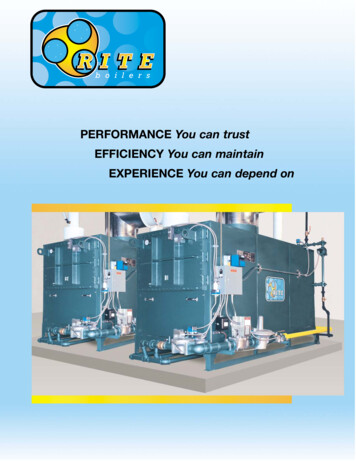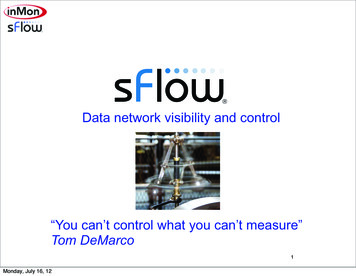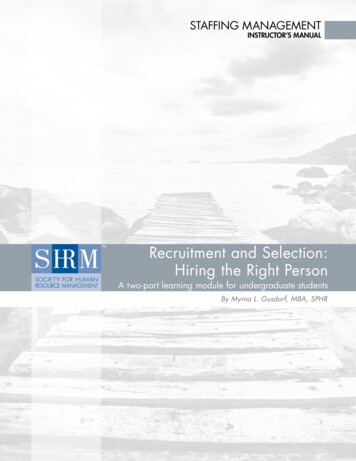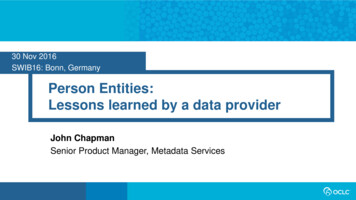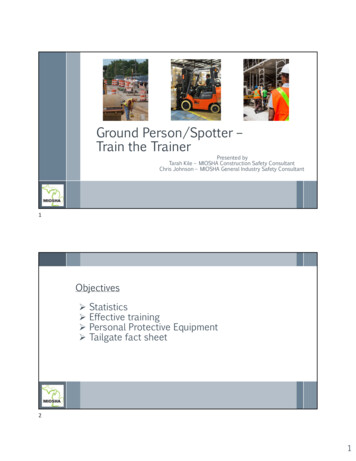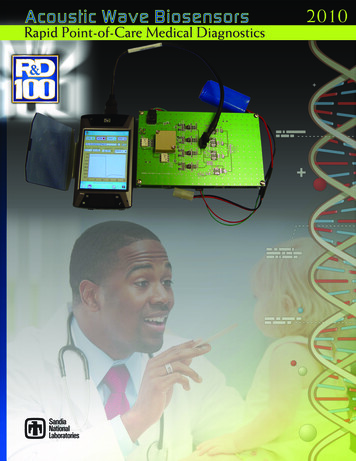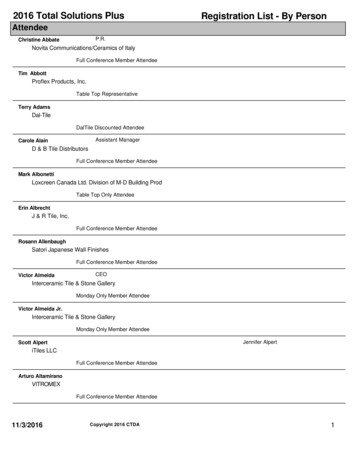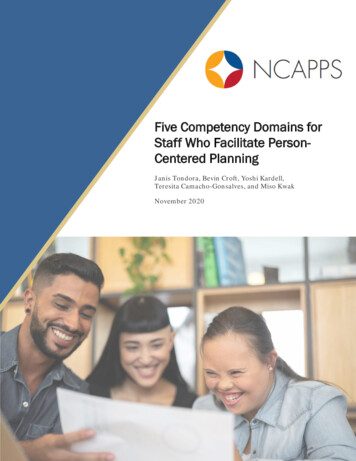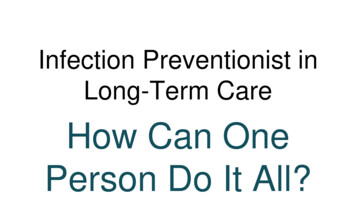
Transcription
Infection Preventionist inLong-Term CareHow Can OnePerson Do It All?
Herding Cats
Infection Preventionist Job DescriptionPosition OverviewThe Infection Preventionist reports to the Director of Nursing and partners with the Medical Director, the Administratoror Quality Officer, and other stakeholders to develop a system of care that promotes sound and scientific infectionprevention principles and practices.This individual is accountable for decreasing the incidence and transmission of infectious diseases between patients,staff, visitors and the community. Through strategic planning, leadership and consultation, you will lead and direct arobust team in the identification and implementation of infection prevention goals and objectives throughout thefacility.Position Responsibilities and QualificationsIn this key position, essential job duties and responsibilities include: Partners with the Medical Director for Epidemiology/Infectious Disease to develop, implement and evaluate annual infectionprevention goals and action planPartners with facility leaders, physicians, local, state, and national agencies on activities related to infection preventionOversees the operations of the infection prevention, epidemiology, industrial hygiene, and relevant safety programsAccountable for surveillance of healthcare acquired and community acquired infectionsManages goal setting process for system, unit and physician goals related to healthcare acquired infections and conditionsLead industrial hygiene program to anticipate, recognize, evaluate, mitigate and control workplace conditionsParticipates in the national collaboratives and external reporting to CDC NHSN system, and other post acute-care specificquality organizations
Great tools exist for training associates easilyhttps://www.youtube.com/watch?v 06xA-tsnBEY
Great tools exist for training associates easilyhttps://www.youtube.com/watch?v byIVejlZa1A
Great tools exist for training associates easilyhttps://www.youtube.com/watch?v 5uZjgGD 9vY
Great tools exist for training associates easilyhttps://www.youtube.com/watch?v SeaIY7kP2uI
Why Is It So Hard?Back to Herding Cats!
Infection Preventionist/ Director of StaffDevelopment/ Assistant Director of Nursing3 AM-5 AM Call from Noc shift CNA that he is sick and going home early. Callfrom AM CNA that her child is sick and she can’t come to work today. Startsending texts to fill the vacant shifts.6 AM-8 AM Personal prep. Continue to worry about everyone showing up to workon time. Get to work.9 AM-11 AM Verify new admissions are comfortable. Gather data for review ofinfection present in facility, trends, proper prevention and notification in place.Attend Inter-Disciplinary Team meeting.
Infection Preventionist/ Director of StaffDevelopment/ Assistant Director of Nursing12 PM-3 PM Training class for AM/PM shift. Interview 2 CNA candidates. Verifystaffing levels correct for remainder of the day and night. Round to verifyPrevention and Protection techniques are being correctly followed.4 PM-6 PM Help in the dining room to cover feeding a resident for the PM CNAwho was late due to car problems. Verify the Infection Prevention monthlysummary presentation including comparing facility-acquired and communityacquired infections. Start tracking 1 new case of possible GI concern.7 PM- 2 AM Dream about doing it all over again the next day
How Many Hats Can One Person Wear?
All at the same rdinatorDirector ofStaffDevelopment
Director of Staff Development- RequiredCriteria for the Director of Staff Development (DSD) position in accordance with the California Code of Regulations, Title 22, Division 5, Chapter 2.5,Section 71829.Within six (6) months of employment and prior to teaching a certification program, DSD candidates must obtain a minimum of 24 hours of continuingeducation courses in planning, implementing, and evaluating educational programs.TOPICS COVERED: Characteristics of the Adult LearnerElements of an Instructional ObjectiveCNA Training Requirements in Long-Term Care FacilitiesInstructional Methods for Preparing and Presenting Lesson PlansTeacher Behaviors that Affect Student Classroom InteractionDSD QUALIFICATIONS:To qualify as a DSD, the candidate must be an RN or LVN and satisfy one of the following:Option 1: Have one year experience as a licensed nurse providing direct patient care in a long-term care facility, IN ADDITION to having one year ofexperience planning, implementing, and evaluating educational programs in nursing (for a total of two years).Option 2: Have two-years full time experience as a licensed nurse, at least one of which must be in the provision of direct patient care in a nursingfacility.
Infection Preventionist- RequiredNew Infection Preventionist specialized training requirement finalized by CMS in the Reform of Requirements ofParticipation for Long Term Care Facilities. Infection Preventionist Specialized Training (IPCO) course, individuals will bespecially trained to effectively implement and manage an Infection Prevention and Control Program at their center. A thorough explanation of the impact of infections on the people who live, work and visit nursing centers.Definitions of essential components of an effective infection prevention and control program.Identification and management of common infections.Strategies to prevent the spread of infections.Identification and description of the steps necessary for infection surveillance, antibiotic stewardship,investigating, tracking and reporting infectionsSuccessful implementation strategies.It addresses both clinical and organizational systems, processes and culturalaspects of infection prevention and control which are fundamental to effectivelyleading and administering a center’s Infection Prevention & Control program.
CMS/State Survey- Regulation Requirements
CMS/State Survey- Regulation Requirements Provide evidence within 4 hours Infection Prevention and Control ProgramStandards, Policies and Procedures, andAntibiotic Stewardship Program Influenza/ Pneumococcal Immunization Policyand Procedure
CMS/State Survey- Regulation dance/Guidance/Manuals/downloads/som107ap pp guidelines ltcf.pdf
CMS/State Survey- Regulation lations/Nursing-Homes.html
Unique Role of the IP“There are two pieces that are unique to what IPs and healthcare epidemiologistsbring to the table:Data --- knowing what is happening in your institution.Knowledge--- knowing what needs to be done to prevent infections.Those are the reasons people will invite you when discussing problems related tohealthcare safety --- because it’s something the others don’t know. It’s what givesus the power.”Denise Cardo, MD, Director CDC’s Division of Healthcare Quality Promotion
Professional Standards for IPsProfessional Accountability:Acquire and maintain knowledge and skills –Attend educational conferences –Join professional organizations » APIC » SHEA –Participate in State and local public health events
APIChttps://apic.org/Education-and-Events/Overview
APIChttp://webinars.apic.org/IP Competency Quick Reference.pdf
rm-carefacility
IP as Evaluator Annual Risk Assessment Infection Prevention Plan Unit rounding Perform surveillance Investigate suspected outbreaks Educate based on prevention needs/problems
IP as HAI Prevention Expert Use epidemiology and microbiology skills Analyze, interpret, and feedback surveillance data Frequent review of HAI surveillance findings with healthcare providers andleadership: Identifies areas for prevention focus Spurs new prevention efforts Measures progress and sustainability of prevention efforts over time
IP as Educator Teach others: staff, visitors, and patientsEvidence-based infection prevention practicesInfection risk, prevention and control methodsAnnual Bloodborne Pathogens and Aerosolized Transmissible Diseases(ATD) classesUpdates on Pandemics Influenza, Pertussis, MeaslesNew Employee OrientationVolunteersCommunity Classes
IP as Mentor and Leader IPs are role models and leaders Staff watch your behaviors You make decisions related to ethics and regulations You are responsible for IP policies and procedures IPs should identify needs/desire for mentorship Staff nurses interested in IP Students needing a preceptor Begin an IP Liaison team
IP as Consultant and Influencer Family and visitor issues Dietary, EVS, Lab Pet Therapy Pandemic!!! Construction Floods, Fires
IP as Customer Service Who are infection prevention customers? Residents/Family Members Staff Physicians Visitors/Community Public Health Anyone who calls for your consultation services!
Infection Preventionist- RequiredEven though nursing facilities are not required to have a designated “Infection Preventionist” untilNovember 2019, there are three compelling reasons why it is critical to register for this training now: As of November 28, 2016 nursing facilities are being held accountable to more expansiveinfection prevention and control federal regulations. Beginning November 28, 2017, the federal requirements for nursing facilities expand further andrequire that every nursing facility develop and implement an antibiotic stewardship program.This is a new requirement that should be conducted with oversight from specially trainedhealthcare professionals. Surveyors nationwide were trained this summer to survey for the expanded infection prevention& control and antibiotic stewardship requirements.
As of November 28, 2016 nursing facilities are being held accountable to more expansive infection prevention and control federal regulations. Beginning November 28, 2017, the federal requirements for nursing facilities expand further and require that every nursing facility develop and implement an antibiotic stewardship program.



